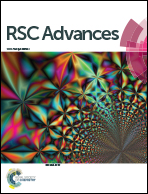Li/Ag2VO2PO4 batteries: the roles of composite electrode constituents on electrochemistry†
Abstract
In this study, we utilize silver vanadium phosphorous oxide, Ag2VO2PO4, as a model system to systematically study the impact of the constituents of a composite electrode, including polymeric and conductive additives, on electrochemistry. Notably, although highly resistive, this bimetallic cathode can be discharged as a pure electroactive material in the absence of a conductive additive as it generates an in situ conductive matrix via a reduction displacement reaction resulting in the formation of silver metal nanoparticles. Three different electrode compositions were investigated: Ag2VO2PO4 only, Ag2VO2PO4 with binder, and Ag2VO2PO4 with binder and carbon. Constant current discharge, pulse testing and impedance spectroscopy measurements were used to characterize the electrochemical properties of the electrodes as a function of depth of discharge. In situ EDXRD was used to spatially resolve the discharge progression within the cathode by following the formation of Ag0. Ex situ XRD and EXAFS modeling were used to quantify the amount of Ag0 formed. Results indicate that the metal center reduced (V5+ or Ag+) was highly dependent on composite composition (presence of PTFE, carbon), depth of discharge (Ag0 nanoparticle formation), and spatial location within the cathode. The addition of a binder was found to increase cell polarization, and the percolation network provided by the carbon in the presence of PTFE was further increased with reduction and formation of Ag0. This study provides insight into the factors controlling the electrochemistry of resistive active materials in composite electrodes.


 Please wait while we load your content...
Please wait while we load your content...